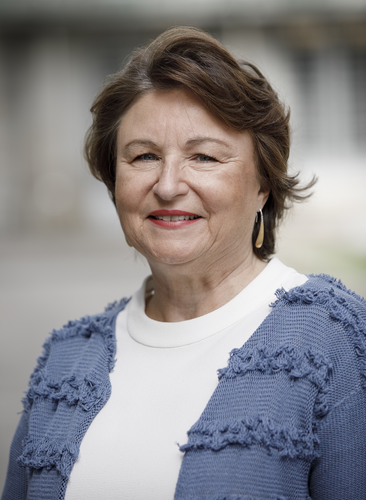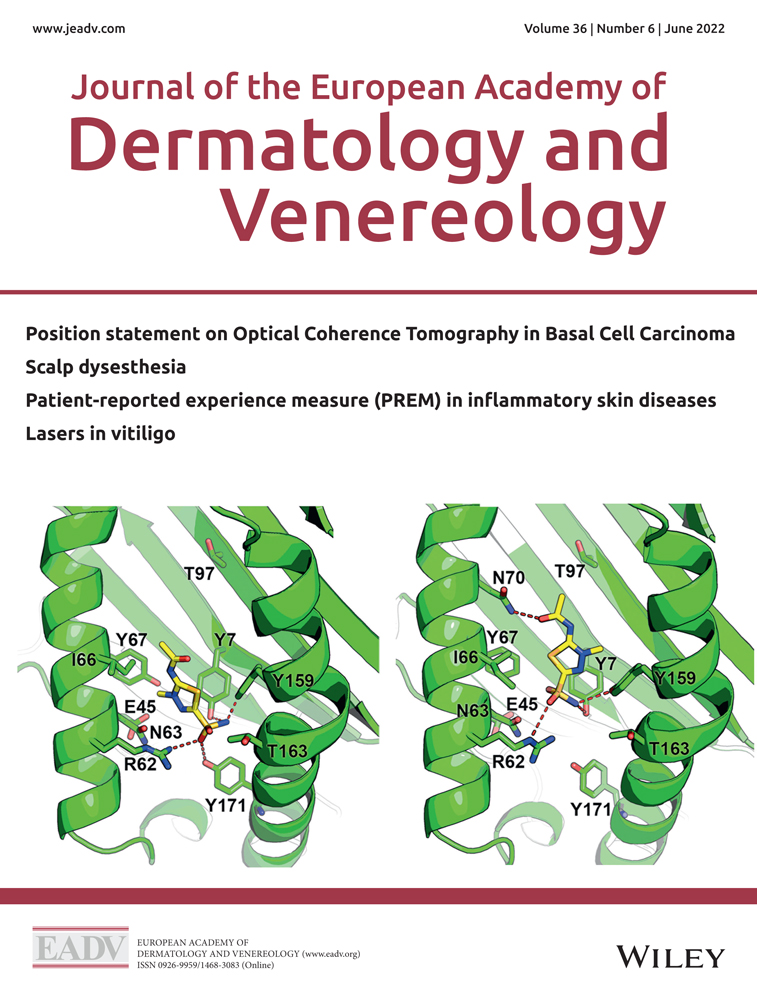Pioneers in Dermatology and Venereology: an Interview with Professor Beatrix Volc-Platzer
Conflicts of interest
None declared.
Funding source
None declared.
Curriculum vitae
Beatrix Volc-Platzer is a board-certified dermatologist and venereologist, and associate professor of Dermatology and Venereology focusing on the main topics of immunodermatology, dermatohistopathology and paediatric dermatology. Beatrix Volc-Platzer graduated in 1978, from the University of Innsbruck, Austria. From 1979 to 1980, she was a resident at the Institute of Pathology, University of Vienna, and from 1980 to 1987, a resident in Dermatology and Venereology at the Departments of Dermatology at the Universities of Innsbruck and Vienna, Austria (Head: Professor Klaus Wolff, MD) and member of the immunodermatology team of Professor Georg Stingl, MD. She received her ‘habilitation’ in 1989 and became an associate professor in 1995. She worked as a researcher at the former Sandoz Research Institute in Vienna for the project ‘Gene therapy for AIDS’ (1992–1994). In 2001, she was appointed Head of the Department of Dermatology at the Donauspital SMZ Ost, Vienna, Austria, and retired in 2019.
She was a board member of the European Society of Dermatological Research (ESDR) (1994–1999); president of the Austrian Society of Dermatology and Venerology (ÖGDV) (2008–2010); head of the Working Party for Paediatric Dermatology of the ÖGDV; and founder of the Karl Landsteiner Institute for Paediatric Dermatology in 2012. Beatrix Volc-Platzer is vice president of the Karl Landsteiner Society and has been appointed as the first woman president of the ‘College of Physicians in Vienna’ (Gesellschaft der Ärzte in Wien), on 28 October 2020.
Prof. Volc-Platzer's research and clinical topics include immunopathology of Graft-versus-host Disease, diagnostic parameters and treatments of autoimmune diseases, i.e. connective tissue diseases and autoimmune bullous diseases, and paediatric dermatology. Her publications include ‘Expression of class II alloantigens by keratinocytes’ (J Exp Med 1984) and ‘On the bone marrow origin of human Langerhans cells’ (N Engl J Med 1984). Her recent publications include ‘European Guidelines of IVIG’ (J Eur Acad Dermatol Venereol and J Dtsch Dermatol Ges 2017), ‘EDF/EADV Guidelines on the treatment of cutaneous lupus/CLE’ (J Eur Acad Dermatol Venereol 2017), ‘Dermatomyositis’ (Hautarzt 2015) and on rare diseases in children, e.g. (Br J Dermatol 2017, 2019, 2020). Contribution to Harper's Paediatric Dermatology, 4th Ed., with the chapter on ‘Skin manifestations of Metabolic Syndrome’. Beatrix Volc-Platzer is a peer reviewer for several journals, e.g. J Invest Dermatol, Br J Dermatol, Clin Exp Dermatol, Acta Dermatovenereol, J Dtsch Dermatol Ges, and was appointed as Associate Editor for the Br J Dermatol in 2016.
In 1984, she received ‘Ferdinand von Hebra-Award’ of the Austrian Society of Dermatology and Venerology (ÖGDV) for her research on ‘Class II alloantigen expression on keratinocytes’ and in 1989, she received the AESCA Award of the ÖGDV for ‘Sequential immunohistological analysis of the skin after allogeneic bone marrow transplantation’.
Beatrix Volc-Platzer was the founder of the annual interdisciplinary symposium of paediatric dermatology (‘Kinder-Haut-Tag’) in 2010, under the auspices of the ÖGDV, the Karl Landsteiner Society and the Austrian Society for Paediatrics. She still is a lecturer for the Medical University of Vienna on ‘Autoimmune Diseases of the Skin’ and ‘Paediatric Dermatology’.
Beatrix Volc-Platzer and her husband live in Vienna. She has two children and two grandchildren.
What brought you to Dermatology?
Curiosity and Klaus Wolff. My sense of curiosity was piqued by Klaus Wolff in his famous lectures, where he taught us diagnostic clues to skin diseases in a most vivid manner. He depicted skin diseases, not only as organ restricted but also as symptoms of systemic diseases. In addition, I was fascinated by the overt possibilities of connecting research and clinical work.
Who were your most important teachers? From whom did you learn most?
Klaus Wolff and Georg Stingl.
Please list five of your best publications?
- Volc-Platzer B, Majdic O, Knapp W, Wolff K, Hinterberger W, Lechner K, Stingl G. Evidence for Ia-antigen biosynthesis by human keratinocytes in disease. J Exp Med. 1984; 159:1784–1789.
- Volc-Platzer B, Stingl G, Wolff K, Hinterberger W, Schnedl W. Cytogenetic identification of allogeneic epidermal Langerhans cells in a bone-marrow graft recipient. N Engl J Med. 1984; 310:1123–1124.
- Volc-Platzer B, Leibl H, Luger T, Zahn G, Stingl G. Human epidermal cells synthesize HLA-DR alloantigens in vitro upon stimulation with gamma-interferon. J Invest Dermatol. 1985; 85:16–19.
- Volc-Platzer B, Groh V, Wolff K. Differential expression of class II alloantigens on epidermal cells. J Invest Dermatol. 1987; 89:64–68.
- Volc-Platzer B, Rappersberger K, Mosberger I, Hinterberger W, Emminger-Schmidmeier W, Radaszkiewicz T, Wolff K. Sequential immunohistological analysis of the skin following allogeneic bone marrow transplantation. J Invest Dermatol. 1988; 91:162–168.
- Volc-Platzer B, Hönigsmann H, Hinterberger W, Wolff K. Photochemotherapy improves chronic cutaneous graft-versus-host disease. J Am Acad Dermatol. 1990; 23:220–228.
Have you ever been president or in the leadership of an academic society?
I served on the Board of the Austrian Society of Dermatology and Venerology (OEDGV) from 2003 to 2020 and was the president of our society from 2008 to 2010. In 2020, I was elected president of the ‘College of Physicians in Vienna’, one of the oldest medical societies worldwide. Since 2013, I am vice president of the Austrian Karl Landsteiner Society, another multidisciplinary society with a focus on clinical research in medicine.
From 1995 to 1999, I served as a board member of the European Society for Dermatological Research (ESDR). It was a great honour for me to be part of the programme committee of the Trisociety Meeting in Cologne in 1998.
What was your greatest achievement in your professional life?
- First description of the synthesis of class II alloantigens by keratinocytes in lichen planus, cutaneous T cell lymphoma and cutaneous graft-versus-host disease and, in consequence, proof for it by in vitro experiments. In the context of further studies in cutaneous graft-versus-host disease, the first visualization of bone marrow origin of human Langerhans cells in the skin of a female patient who had received a bone marrow graft from her brother.
- Being the Head of the Department of Dermatology at the Donauspital, Vienna, Austria.
- Supporting the development of paediatric dermatology in Austria and founding of the ‘Kinder-Haut-Tag’, an interdisciplinary symposium for dermatologists and paediatricians, with increasing numbers of participants since 2010.
What was the greatest disappointment in your professional life?
To see continuous erosions in our discipline (as in several other ‘small’ disciplines) under the pretext of economic constraints.
Can you tell us any funny episodes from your professional life?
I remember a ward with approximately 30 beds, for male patients in the former 1st Department of Dermatology at the University of Vienna (former ‘Hebra Dermatology Department’). All patients were quite disciplined in taking off their clothes for the dermatologic examination, except for their socks – which seemed to me as a peculiar Viennese habit. One day, around Christmas, we recognized an armada of body lice on the curtains, which were used at that time to separate beds in large wards…
Who is your favourite composer, writer, or painter?
Composer: Ludwig van Beethoven.
Writer: Umberto Eco.
Painter: Raffaello Sanzio da Urbino, Paul Klee.
Apart from dermatology, what is your major interest?
History and art.
Whom would you list as the most influential dermatologists in history?
- Klaus Wolff.
- Otto Braun-Falco.
- Ernst Macher.
- Stephen I. Katz.
- John I. Harper.
- Thomas B. Fitzpatrick.
- Stefania Jablonska.
- Bernard Ackerman.
Whom would you list among the top ten of living dermatologists?
- Leena Bruckner-Tuderman.
- Jean Bologna.
- Christine Bodemer.
- Georg Stingl.
- Peter Fritsch.
- Gerd Plewig.
- Michael Hertl.
- Johannes Ring.
- Lars French.
- Helmut Kerl.
- Martin Röcken.
What will be the greatest problem for Dermatology in the next ten years?
- ‘Dermatology without beds’ – this emerging concept, which is driven by pure economic intentions and already realized in several countries (Scandinavia, Italy, UK, USA,…) inevitably leads to loss of experience and skills among nurses, loss of quality in residents' training and reduced quality of patient care with definite dermatologic conditions, i.e. Pemphigus and Pemphigoid diseases, chronic inflammatory diseases such as psoriasis and atopic eczema and their erythrodermic variants, severe adverse drug reactions, skin tumours including melanoma.
- Dermatology is ‘Medicine in a nutshell’ (Peter Fritsch). The beauty of this discipline, and the danger in getting split up, lies in its diversity.
What will be the next breakthrough in the coming ten years in Dermatology?
- Telemedicine.
- Genomic/proteomic … profiles of the patients with skin disease.
- Increasing individualization of dermatologic treatment.
*Note: The Pioneers in Dermatology and Venereology interview was conceived and conducted by Johannes Ring.





